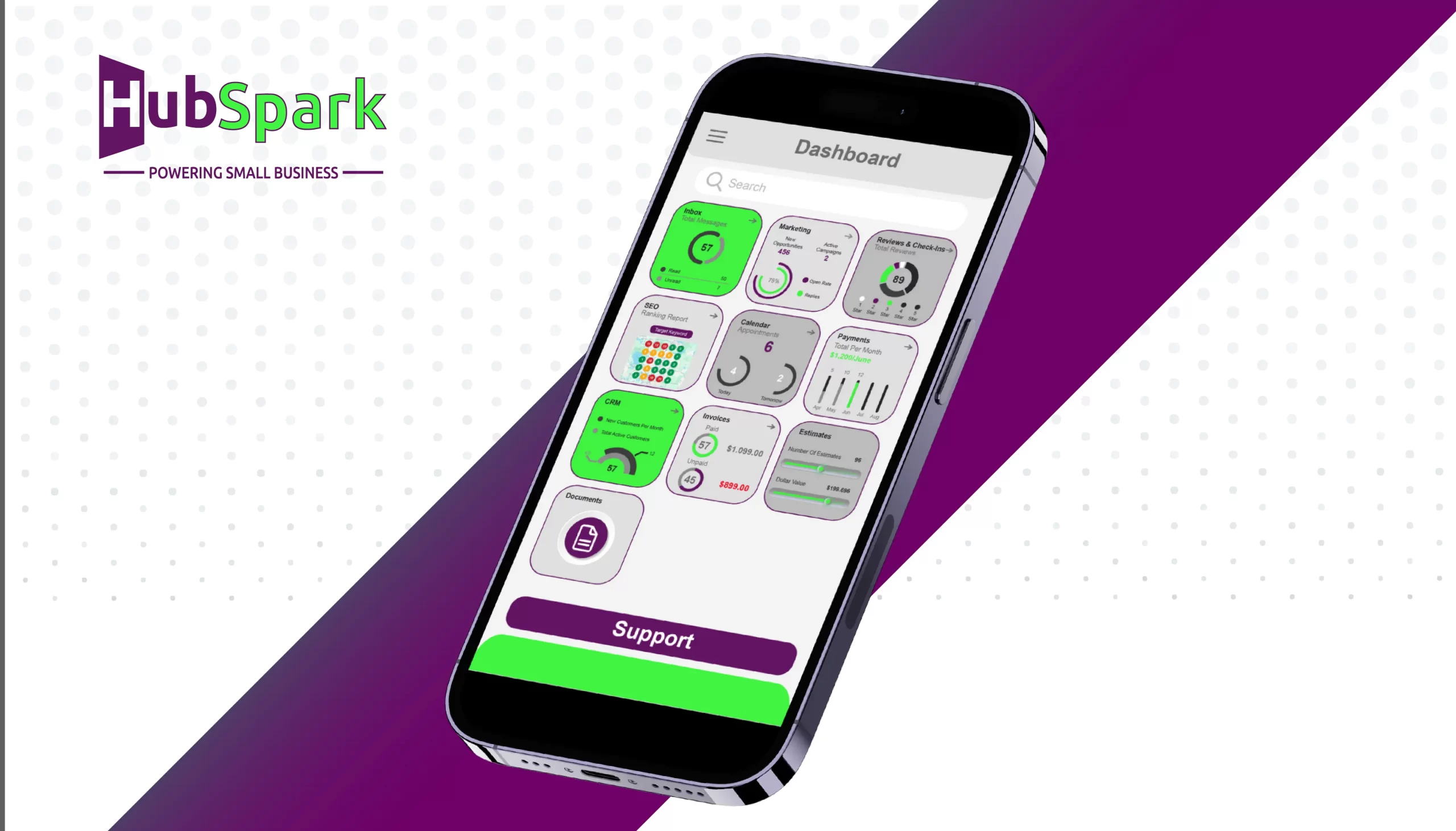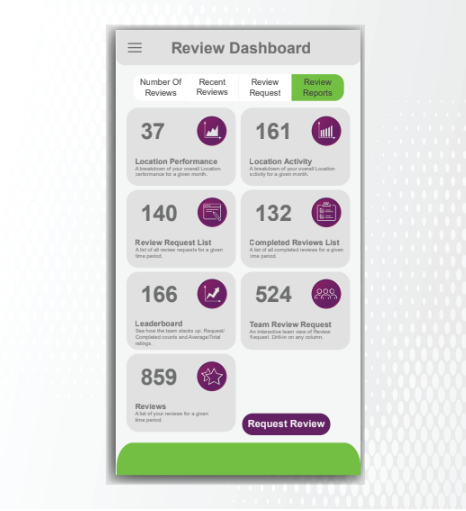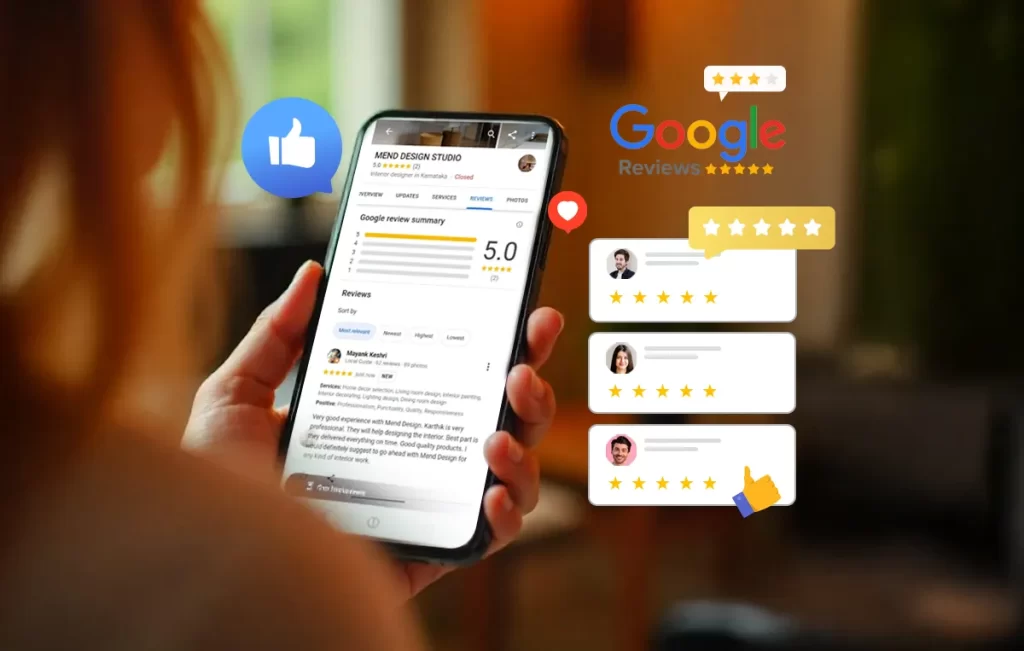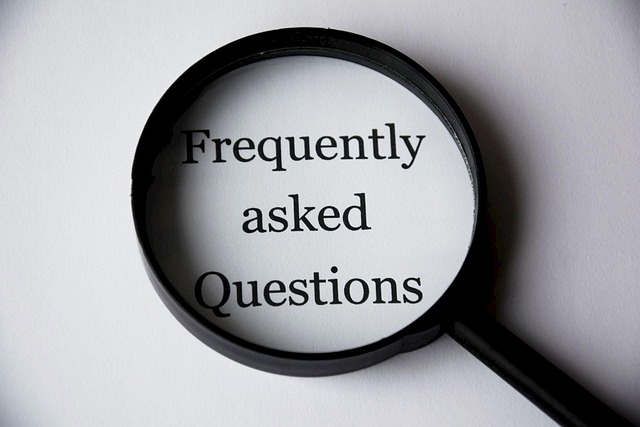How to Get More Google Reviews with HubSpark

Key Takeaways
- We emphasize that a well-optimized GBP is the cornerstone of any successful review generation strategy. This profile becomes your main online fingerprint, directly accessing consumer psychology to establish trust and reinforce the validity of your business long before a prospect even contacts you.
- We’ve found that a multi-channel request system works best, because it really boosts review velocity. Your strategy should combine direct asks, digital nudges embedded in email signatures and newsletters, and physical touchpoints like QR codes on receipts to make the feedback process as frictionless as possible for every type of customer.
- Our experience indicates that automating the post-service follow-up is an essential part of consistently obtaining high-grade feedback. Using a centralized platform to send personalized review requests helps HubSpark users stay consistent and makes your team less likely to forget or get distracted.
- We recommend that you establish a reputation management plan to respond to all reviews, positive and negative. Responding to negative reviews in a professional and constructive manner shows that you’re responsible and can sometimes turn an angry customer into a brand loyalist.
- Your team must also follow Google’s strict code of ethics, which prohibits offering rewards or requesting fraudulent reviews. Being transparent and genuine in your review solicitation process is the most important factor for long-term credibility and ensuring your Google business profile does not face any potential penalties.
- We suggest you regularly evaluate the effectiveness of your review strategy by monitoring metrics like review velocity and average star rating and sentiment. This data-driven strategy lets you make strategic adjustments, fine-tune your tactics and identify customer perceptions with more precision.

To generate Google reviews, we employ a simple outreach sequence that delivers a direct, shareable Google review link to your customers after service.
Our approach includes a follow-up sequence to collect feedback from non-respondents. This process can use our HubSpark CRM data of your customers to send a Google review request, boosting conversion rates.
Our guide explains this system to assist you in establishing social proof and enhancing your local search rankings. If you want to generate more Google reviews for your small business, HubSpark is a gamechanger. Contact us today to get started on generating more Google reviews!
The Psychology of Reviews
eviews appeal to some basic psychology on how people behave as consumers. They offer a way to establish trust and reduce the sense of risk involved in any transaction. They want to learn more about your products or services from others who have used your business. By reading others’ experiences, potential customers can validate their own decision making and create a sense of community and camaraderie.
This communal voice can set off its own strong bandwagon effect, where a building base of positive feedback drives additional interest in a product or service.

Customer Motivation
The motivation to write a review is a complicated cocktail of incentives. Above all, consumers want to post their stories – good or bad – to allow others to make better choices. This sharing tends to be motivated by a sense of community or passion.
We discover that a lot of consumers want affirmation as well. A positive review validates their choice — it proves they were smart to spend the money. On the flip side, negative reviews aren’t always vengeful — studies indicate that only 20% are.
Most are a means of giving constructive criticism or alerting others of dangers, a decent kind of social service. After all, solving problems for customers is a strong incentive. When we pay attention and respond to feedback, it demonstrates to customers that their voice is important — which lends motivation for sharing their thoughts in a public forum.
Business Credibility
Google reviews are a pillar of contemporary business trust building. They provide a clear, outside view of a company’s work which is usually more convincing than marketing. We observe that an ongoing flow of fresh, positive reviews establishes a great deal of trust and confidence for a brand, directly impacting a potential customer’s choice to do business with us.
The star rating provides the instant hook, but the text of the reviews gives you the nuance. Oddly, a Google profile with no criticism at all can come across as suspicious. They prefer a 4-star average to a perfect 5, because it suggests a less clean and more believable sample of experiences.
Brutal reviews help squelch expectations and deflate enthusiasm by emphasizing potential shortcomings, thereby lowering the risk of subsequent letdown. A good ratio — say ten complimentary to each critical — indicates a dependable, reputable operation, not a flawless one.

Reviews are perhaps the most potent form of social proof, a psychological phenomenon where we mimic what we see others doing under the assumption that it’s the appropriate behavior. When prospects see people like themselves recommending a service, it confirms the company’s claims and greatly reduces the purchase risk.
Especially when two products have similar ratings, according to research, customers will still almost always choose the one with more reviews, as the greater sample size offers greater social validation.
How to Get Google Reviews
To establish a robust online presence, you need to take charge of your reputation. A passive approach is hit or miss, so you should employ a systematic tactic to solicit client input. For example, this means building a frictionless channel for customers to spread the word at multiple touchpoints, online and offline.
At the heart of this strategy is making it as easy as possible to leave a review, because you want to capture real feedback that helps you grow and helps potential customers.
1. Foundational Setup
The first thing is to create a strong digital presence by claiming and carefully verifying your Google Business Profile (GBP). This is non-negotiable, as it gives you the administrative access required to respond to and manage reviews, which gets more customers to leave them.
Make sure all of your business info is up to date and complete, from your address and contacts to your hours of operation. You want to fill out your profile with quality photos and a comprehensive business description to provide possible reviewers with a complete sense of who you are and the services you provide.
A key piece of this configuration is creating a convenient, shareable Google review link. This plain URL eliminates the friction by literally transporting clients to the page where they can write the review, instead of forcing them to hunt down your Google business profile, which enormously increases the chance they’ll actually follow through and provide it.

2. Digital Integration
Weave review requests into your digital ecosystem. Have a prominent call to action on your site, usually along with a specific page where you can highlight some of your reviews and link out to leave one.
This includes your emails as well. You can embed the review link in your regular email signatures and newsletters, providing an ongoing, low-pressure request for input. You can also use social media to feature good testimonials, which creates social proof and gently encourages other followers to contribute.

3. Physical Touchpoints
You can connect offline experiences and online reviews with tangible assets. That means including an easy to find and use ask and QR code on your business cards and receipts.
The QR code takes them straight to your Google review, so it’s easy for a customer with a smartphone to leave feedback on the spot. You can also do thank-you cards after a service, which can be a little more personal and get a more thoughtful review.

4. Direct Google Review Requests
We believe in the magic of a direct ask, perfectly timed. Your employees who directly work with your customers should be taught to ask for reviews nicely and professionally when the good feelings are at their highest point, like right after a project or service call.
The trick is personal and timely. A blanket, mass request is a million times less effective than a note that references a specific interaction. For example, an email may read, “We hope you are loving the new system we established. When you have a second, we would love for you to tell a little about your experience on Google.”
This tactic comes across authentic and considerate of the customer’s time, positioning the ask as a quick rating that requires just a moment.

5. Post-Service Follow-up
Automated follow-up emails are at the core of our HubSpark review generation system. You can queue these messages a few days after a service to allow the client time to experience the fruits of your labor.
Each note is customized with the client’s name and a message that can provide insight into the service you provided. You always start by thanking them for their business before you ask for a Google review.
For more specific insights you can sometimes use a short internal survey first. If it’s positive, the survey thank you page then can send your customer to your Google review page to leave their public thoughts.


How to Get More Google Reviews with HubSpark
We use automation to streamline the Google review process for online reputation management and growth. Our platform, HubSpark, is designed to automate review generation, from request through analytics. It composes review invites, tracks campaign results, and does reputation management, which all feeds local SEO and leads for more businesses.
Centralized Dashboard
HubSpark provides one, central dashboard where you can easily control all of your Google reviews. This interface centralizes all incoming feedback, giving you a clear picture of your reputation online in one view.
Actively track the progress of your review campaigns, monitor key metrics such as response rate and average rating, and perform sentiment analysis. This review dashboard displays these metrics via simple, easy-to-read visualizations.
With all review information in one place, you’re not bouncing between platforms. This consolidation is a timesaver and simplifier. With HubSpark, you’ll be able to see performance trends and where you need to focus.
Request Automation
HubSpark can automate the whole process of sending Google review requests to your customers. We allow you to create and schedule targeted campaigns via email and texts.
With text messages boasting an open rate often above 95%, this channel is especially powerful for contacting your customers immediately. It’s deeply personalized, using customer information like their name and other contact information to customize each request, making a review much more likely.
It even automates follow-up sequences. If a customer doesn’t respond to the first Google review request, for example, our HubSpark platform can issue a gentle reminder after a certain period of time, so you get their feedback without having to do anything. Genius, if we do say so ourselves!
Performance Tracking
We offer powerful tracking tools for your Google review campaigns, providing you with valuable insights to optimize your strategy. Review velocity alongside your average star rating can be tracked via our HubSpark Review’s dashboard.
By measuring what campaigns perform the best, you know what tactics work and where you can reallocate resources as well as where you need to improve based on the customer feedback. This ongoing optimization loop keeps your review strategy efficient and flexible.

Manage Your Online Reputation
Sincerely managing your online reputation is not the icing on the cake, it is a foundation of the cake. Since close to 62% of online shoppers check out a company prior to buying, it’s the reviews they read that affect their purchase decisions. Your Google reviews are an online reflection of your brand’s value.
You shouldn’t feel doing this as a defensive chore, but as a chance to connect with your community, learn from the input, and show your passion for quality.
Responding to Positive Google Reviews
You should never say no to kind words! Always respond to positive Google reviews through the HubSpark app with a heartfelt thank you. This easy gesture illustrates gratitude and further cements the customer’s positive interaction.
Personalizing your response is the key. Not a canned response — cite specific things from their review. If they call out a wonderful team member or an awesome feature, you should point that out. This validates their input and demonstrates that you are paying attention to it.
View good reviews as assets. Posting them on your social media channels or website helps create social proof and multiplies the positive mojo, demonstrating the value your business provide to potential buyers.
This approach transforms one positive experience into a viral marketing message, cultivating loyalty and getting other people to tell their friends to participate with your business.
Addressing Negative Google Reviews
When it comes to criticism, this is a great chance to get better and make good with the customer. Your initial action is to react quickly and professionally, which you should usually do within 24-48 hours. You should start by simply recognizing the customer’s frustration, and providing a heartfelt apology for their experience — an important step given 76% of customers observe when companies prioritize support.
This first answer is public, demonstrating to others that you listen and care and are willing to do something about it. You should always validate their emotions, which is the bedrock for a productive discussion.
Make sure to present a straightforward avenue to resolution, like giving out an email or phone number where they can talk to you privately. This trick of moving the conversation offline safeguards the customer’s privacy and lets you collect the information essential to solving the problem.
By managing the resolution offline, you avoid public flame wars and concentrate on a fix, transforming a sour experience into an opportunity to recapture customer loyalty.
Spotting Fake Google Reviews
Identifying and flagging fake reviews is important for maintaining a credible online reputation. You can search for specific review red flags, such as overly general remarks that fail to describe a particular experience or come from empty profiles. An atypical review velocity, with a sudden influx of negative or positive reviews, can indicate a targeted hit or purchased reviews. By being vigilant, you can ensure your profile reflects a more honest representation of your local business.
Google users can report suspicious reviews to Google using the ‘Flag as inappropriate’ button, providing a comment that explains why you believe the review violates their policies. This proactive review strategy is essential for safeguarding your online presence and helps maintain your local search ranking. Ultimately, your goal is to foster a positive customer experience and attract new customers.
A great feature that is built into the HubSpark app is that you can report any suspicious reviews to Google through the ‘Flag as inappropriate’ button that the HubSpark app has built-in to the interface. You can leave a comment explaining why you believe the review breaches Google’s policies. This vigilance helps make sure that your digital reputation is an accurate representation of the service you offer.

Ethical Google Review Guidelines
If you’re going to construct any sort of reputable online identity, you need to get around the review-collecting thing honestly. That is, you adhere to a code of ethics that emphasizes genuineness. Google guidelines disapprove of behaviors such as bulk review solicitations and review gating — which targets positive feedback and filters negative feedback.
We believe real engagement, not gaming, is the path to a great online reputation.
Google’s Policies
You must comply with Google’s review policies. These guidelines explicitly delineate disallowed content and practices—like fake reviews, spam, conflicts of interest, etc. Following these rules isn’t optional — a best practice — it’s necessary for your digital survival.
Breach of Google policies can cause serious issues such as having reviews removed or your GBP suspended. Nobody wants that! HubSpark keeps up with Google policy updates by keeping an eye on Google’s documentation. This makes sure your procedures stay appropriate and your web presence safe!
The Risk of Incentives
Do not provide rewards for reviews. This leads to extreme bias and fake Google reviews, which defeats the point of a review system. When consumers are compensated, or even discounted for their review, it’s not a pure review.
This can harm credibility. Transparency is what matters most. Providing incentives may infringe upon Google’s policies and damage the trust you establish with your community.
Instead, promote natural feedback by responding to every review. Because 52% of consumers anticipate a reply within a week, responding promptly demonstrates that you appreciate their feedback.
This fosters trust and incentivizes more authentic reviews.

Measure Your Online Reputation
Measuring the success of your review strategy is not an endpoint — it’s an ongoing feedback loop. It gives you the information you need to decide what to do, so your efforts are effective. Without regular check-ins, the magic of a strong initial impression fades, which is why regular tracking is key to modifying your efforts for optimal impact.
Key Metrics
We measure key metrics. These hard numbers form the basis of our analysis — revealing your current status and trends over time.
|
Metric |
Description |
Why It Matters |
|---|---|---|
|
Average Star Rating |
The overall score, typically out of 5 stars, aggregated from all reviews. |
A primary indicator of customer satisfaction and a key factor in search rankings. |
|
Total Review Count |
The cumulative number of reviews received on your Google Business Profile. |
Builds social proof and credibility. A higher count often correlates with higher trust. |
|
Review Velocity |
The rate at which you receive new reviews over a specific period. |
Shows current relevance and momentum. A steady stream is better than sporadic bursts. |
Tracking these numbers lets you measure the immediate impact of any new efforts initiated. As an example, if you run an initiative to solicit feedback, you can see the immediate effect on your review quantity and momentum.
Likewise, following your average star rating over time allows you to measure how changes in operations are impacting customer happiness. These aren’t just metrics; they are direct representations of your viewers’ experience and your visibility on the web with an emphasis towards meaningful enhancements.
Review Velocity
Review velocity is how often you collect new reviews. HubSpark can measure this weekly or monthly to get a baseline. A steady stream of fresh reviews tells potential customers and search algorithms alike that your brand is alive and well.
An old review profile, no matter how good, can become stale. Tracking this rate helps you identify trends. A drop in velocity might expose a flaw in your feedback request process, while a spike might be associated with a winning marketing campaign.
If your pace is lagging, you can reformulate. This could be something like optimizing how you request reviews or what stage in a buyer’s journey you make the Google review request.

Contact HubSpark to Start Generating More Google Reviews
HubSpark takes a holistic system approach to Google reviews. We gave you the nuts and bolts on why Google reviews are so important to your local business. You should now also understood the psychology of why people use reviews to make purchasing decisions. Controlling your online identity is vital. Also, tracking things such as review velocity and star ratings indicates what is working to get you more reviews. This also assists you in spotting area for improvement.
HubSpark essentially builds a robust, all-in-one platform that helps your business attract new business. Our HubSpark app was designed for small business owners to scale their business and expand their reach to prospective customers. HubSpark provides business owners and employees cutting-edge features to stay ahead of today’s online marketing. We provide you with a robust built-in CRM, an easy-to-use unified inbox for internal and external messaging, step-by-step citation builder, and SO much more! Contact us today to begin establishing your online reputation and start growing your business!
Frequently Asked Questions
We’ve found that the best way to get Google reviews is to simply ask, nicely. You can use HubSpark to send an email or text that has a direct link to your Google review page. Simplifying the review process for your customers is the key to eliciting a response and ultimately generating more Google reviews.
NO. We do not recommend offering rewards for Google reviews, as this practice can negatively impact your local search ranking and lead to the removal of your reviews. Instead, by utilizing the HubSpark app to generate more Google reviews, you can effectively enhance your online review management strategy without compromising your reputation. It’s always best to get Google reviews legitimately.
We suggest replying promptly and professionally through the HubSpark app, as this is an effective way to enhance your local search ranking. Responding to customer concerns publicly and fixing them offline shows potential reviewers that you’re proactive and care about meaningful reviews.
It saves you time and ensures you never miss a chance to enhance your local search rankings. Our HubsSpark platform can deliver review invites at the ideal time, such as after a sale, effectively boosting your total review count.
Generate & share a short review link from your Google Business Profile. In your profile manager, locate the Get more reviews card and copy the short URL. HubSpark makes this easy for our clients as our software platform connects right to your Google Business Profile.
Unfortunately, you can’t delete a Google review simply because it’s bad. However, HubSpark can assist you in flagging reviews that breach Google’s rules, like fake reviews or spam, which can negatively impact your local search ranking.
Yes, service based and online businesses can take advantage of local SEO by targeting geographical regions and integrating location keywords into their content.

- Key Takeaways
- The Psychology of Reviews
- How to Get Google Reviews
- Automate with HubSpark
- Manage Your Reputation
- Ethical Review Guidelines
- Measure Your Success
- Conclusion
- Frequently Asked Questions

Key Takeaways
- We emphasize that a well-optimized GBP is the cornerstone of any successful review generation strategy. This profile becomes your main online fingerprint, directly accessing consumer psychology to establish trust and reinforce the validity of your business long before a prospect even contacts you.
- We’ve found that a multi-channel request system works best, because it really boosts review velocity. Your strategy should combine direct asks, digital nudges embedded in email signatures and newsletters, and physical touchpoints like QR codes on receipts to make the feedback process as frictionless as possible for every type of customer.
- Our experience indicates that automating the post-service follow-up is an essential part of consistently obtaining high-grade feedback. Using a centralized platform to send personalized review requests helps HubSpark users stay consistent and makes your team less likely to forget or get distracted.
- We recommend that you establish a reputation management plan to respond to all reviews, positive and negative. Responding to negative reviews in a professional and constructive manner shows that you’re responsible and can sometimes turn an angry customer into a brand loyalist.
- Your team must also follow Google’s strict code of ethics, which prohibits offering rewards or requesting fraudulent reviews. Being transparent and genuine in your review solicitation process is the most important factor for long-term credibility and ensuring your Google business profile does not face any potential penalties.
- We suggest you regularly evaluate the effectiveness of your review strategy by monitoring metrics like review velocity and average star rating and sentiment. This data-driven strategy lets you make strategic adjustments, fine-tune your tactics and identify customer perceptions with more precision.

To generate Google reviews, we employ a simple outreach sequence that delivers a direct, shareable Google review link to your customers after service.
Our approach includes a follow-up sequence to collect feedback from non-respondents. This process can use our HubSpark CRM data of your customers to send a Google review request, boosting conversion rates.
Our guide explains this system to assist you in establishing social proof and enhancing your local search rankings. If you want to generate more Google reviews for your small business, HubSpark is a gamechanger. Contact us today to get started on generating more Google reviews!
The Psychology of Reviews

Reviews appeal to some basic psychology on how people behave as consumers. They offer a way to establish trust and reduce the sense of risk involved in any transaction. They want to learn more about your products or services from others who have used your business. By reading others’ experiences, potential customers can validate their own decision making and create a sense of community and camaraderie.
This communal voice can set off its own strong bandwagon effect, where a building base of positive feedback drives additional interest in a product or service.
Customer Motivation
The motivation to write a review is a complicated cocktail of incentives. Above all, consumers want to post their stories – good or bad – to allow others to make better choices. This sharing tends to be motivated by a sense of community or passion.
We discover that a lot of consumers want affirmation as well. A positive review validates their choice — it proves they were smart to spend the money. On the flip side, negative reviews aren’t always vengeful — studies indicate that only 20% are.
Most are a means of giving constructive criticism or alerting others of dangers, a decent kind of social service. After all, solving problems for customers is a strong incentive. When we pay attention and respond to feedback, it demonstrates to customers that their voice is important — which lends motivation for sharing their thoughts in a public forum.
Business Credibility
Google reviews are a pillar of contemporary business trust building. They provide a clear, outside view of a company’s work which is usually more convincing than marketing. We observe that an ongoing flow of fresh, positive reviews establishes a great deal of trust and confidence for a brand, directly impacting a potential customer’s choice to do business with us.
The star rating provides the instant hook, but the text of the reviews gives you the nuance. Oddly, a Google profile with no criticism at all can come across as suspicious. They prefer a 4-star average to a perfect 5, because it suggests a less clean and more believable sample of experiences.
Brutal reviews help squelch expectations and deflate enthusiasm by emphasizing potential shortcomings, thereby lowering the risk of subsequent letdown. A good ratio — say ten complimentary to each critical — indicates a dependable, reputable operation, not a flawless one.
Social Proof
Reviews are perhaps the most potent form of social proof, a psychological phenomenon where we mimic what we see others doing under the assumption that it’s the appropriate behavior. When prospects see people like themselves recommending a service, it confirms the company’s claims and greatly reduces the purchase risk.
Especially when two products have similar ratings, according to research, customers will still almost always choose the one with more reviews, as the greater sample size offers greater social validation.
How to Get Google Reviews

To establish a robust online presence, you need to take charge of your reputation. A passive approach is hit or miss, so you should employ a systematic tactic to solicit client input. For example, this means building a frictionless channel for customers to spread the word at multiple touchpoints, online and offline.
At the heart of this strategy is making it as easy as possible to leave a review, because you want to capture real feedback that helps you grow and helps potential customers.
1. Foundational Setup
The first thing is to create a strong digital presence by claiming and carefully verifying your Google Business Profile (GBP). This is non-negotiable, as it gives you the administrative access required to respond to and manage reviews, which gets more customers to leave them.
Make sure all of your business info is up to date and complete, from your address and contacts to your hours of operation. You want to fill out your profile with quality photos and a comprehensive business description to provide possible reviewers with a complete sense of who you are and the services you provide.
A key piece of this configuration is creating a convenient, shareable Google review link. This plain URL eliminates the friction by literally transporting clients to the page where they can write the review, instead of forcing them to hunt down your Google business profile, which enormously increases the chance they’ll actually follow through and provide it.
2. Digital Integration
Weave review requests into your digital ecosystem. Have a prominent call to action on your site, usually along with a specific page where you can highlight some of your reviews and link out to leave one.
This includes your emails as well. You can embed the review link in your regular email signatures and newsletters, providing an ongoing, low-pressure request for input. You can also use social media to feature good testimonials, which creates social proof and gently encourages other followers to contribute.
3. Physical Touchpoints
You can connect offline experiences and online reviews with tangible assets. That means including an easy to find and use ask and QR code on your business cards and receipts.
The QR code takes them straight to your Google review, so it’s easy for a customer with a smartphone to leave feedback on the spot. You can also do thank-you cards after a service, which can be a little more personal and get a more thoughtful review.
4. Direct Google Review Requests
We believe in the magic of a direct ask, perfectly timed. Your employees who directly work with your customers should be taught to ask for reviews nicely and professionally when the good feelings are at their highest point, like right after a project or service call.
The trick is personal and timely. A blanket, mass request is a million times less effective than a note that references a specific interaction. For example, an email may read, “We hope you are loving the new system we established. When you have a second, we would love for you to tell a little about your experience on Google.”
This tactic comes across authentic and considerate of the customer’s time, positioning the ask as a quick rating that requires just a moment.
5. Post-Service Follow-up
Automated follow-up emails are at the core of our HubSpark review generation system. You can queue these messages a few days after a service to allow the client time to experience the fruits of your labor.
Each note is customized with the client’s name and a message that can provide insight into the service you provided. You always start by thanking them for their business before you ask for a Google review.
For more specific insights you can sometimes use a short internal survey first. If it’s positive, the survey thank you page then can send your customer to your Google review page to leave their public thoughts.
How to Get More Google Reviews with HubSpark

We use automation to streamline the Google review process for online reputation management and growth. Our platform, HubSpark, is designed to automate review generation, from request through analytics. It composes review invites, tracks campaign results, and does reputation management, which all feeds local SEO and leads for more businesses.
Centralized Dashboard
HubSpark provides one, central dashboard where you can easily control all of your Google reviews. This interface centralizes all incoming feedback, giving you a clear picture of your reputation online in one view.
Actively track the progress of your review campaigns, monitor key metrics such as response rate and average rating, and perform sentiment analysis. This review dashboard displays these metrics via simple, easy-to-read visualizations.
With all review information in one place, you’re not bouncing between platforms. This consolidation is a timesaver and simplifier. With HubSpark, you’ll be able to see performance trends and where you need to focus.
Request Automation
HubSpark can automate the whole process of sending Google review requests to your customers. We allow you to create and schedule targeted campaigns via email and texts.
With text messages boasting an open rate often above 95%, this channel is especially powerful for contacting your customers immediately. It’s deeply personalized, using customer information like their name and other contact information to customize each request, making a review much more likely.
It even automates follow-up sequences. If a customer doesn’t respond to the first Google review request, for example, our HubSpark platform can issue a gentle reminder after a certain period of time, so you get their feedback without having to do anything. Genius, if we do say so ourselves!
Performance Tracking
We offer powerful tracking tools for your Google review campaigns, providing you with valuable insights to optimize your strategy. Review velocity alongside your average star rating can be tracked via our HubSpark Review’s dashboard.
By measuring what campaigns perform the best, you know what tactics work and where you can reallocate resources as well as where you need to improve based on the customer feedback. This ongoing optimization loop keeps your review strategy efficient and flexible.
Manage Your Online Reputation

Sincerely managing your online reputation is not the icing on the cake, it is a foundation of the cake. Since close to 62% of online shoppers check out a company prior to buying, it’s the reviews they read that affect their purchase decisions. Your Google reviews are an online reflection of your brand’s value.
You shouldn’t feel doing this as a defensive chore, but as a chance to connect with your community, learn from the input, and show your passion for quality.
Responding to Positive Google Reviews
You should never say no to kind words! Always respond to positive Google reviews through the HubSpark app with a heartfelt thank you. This easy gesture illustrates gratitude and further cements the customer’s positive interaction.
Personalizing your response is the key. Not a canned response — cite specific things from their review. If they call out a wonderful team member or an awesome feature, you should point that out. This validates their input and demonstrates that you are paying attention to it.
View good reviews as assets. Posting them on your social media channels or website helps create social proof and multiplies the positive mojo, demonstrating the value your business provide to potential buyers.
This approach transforms one positive experience into a viral marketing message, cultivating loyalty and getting other people to tell their friends to participate with your business.
Addressing Negative Google Reviews
When it comes to criticism, this is a great chance to get better and make good with the customer. Your initial action is to react quickly and professionally, which you should usually do within 24-48 hours. You should start by simply recognizing the customer’s frustration, and providing a heartfelt apology for their experience — an important step given 76% of customers observe when companies prioritize support.
This first answer is public, demonstrating to others that you listen and care and are willing to do something about it. You should always validate their emotions, which is the bedrock for a productive discussion.
Make sure to present a straightforward avenue to resolution, like giving out an email or phone number where they can talk to you privately. This trick of moving the conversation offline safeguards the customer’s privacy and lets you collect the information essential to solving the problem.
By managing the resolution offline, you avoid public flame wars and concentrate on a fix, transforming a sour experience into an opportunity to recapture customer loyalty.
Spotting Fake Google Reviews
Identifying and flagging fake reviews is important for maintaining a credible online reputation. You can search for specific review red flags, such as overly general remarks that fail to describe a particular experience or come from empty profiles. An atypical review velocity, with a sudden influx of negative or positive reviews, can indicate a targeted hit or purchased reviews. By being vigilant, you can ensure your profile reflects a more honest representation of your local business.
Google users can report suspicious reviews to Google using the ‘Flag as inappropriate’ button, providing a comment that explains why you believe the review violates their policies. This proactive review strategy is essential for safeguarding your online presence and helps maintain your local search ranking. Ultimately, your goal is to foster a positive customer experience and attract new customers.
A great feature that is built into the HubSpark app is that you can report any suspicious reviews to Google through the ‘Flag as inappropriate’ button that the HubSpark app has built-in to the interface. You can leave a comment explaining why you believe the review breaches Google’s policies. This vigilance helps make sure that your digital reputation is an accurate representation of the service you offer.
Ethical Google Review Guidelines

If you’re going to construct any sort of reputable online identity, you need to get around the review-collecting thing honestly. That is, you adhere to a code of ethics that emphasizes genuineness. Google guidelines disapprove of behaviors such as bulk review solicitations and review gating — which targets positive feedback and filters negative feedback.
We believe real engagement, not gaming, is the path to a great online reputation.
Google’s Policies
You must comply with Google’s review policies. These guidelines explicitly delineate disallowed content and practices—like fake reviews, spam, conflicts of interest, etc. Following these rules isn’t optional — a best practice — it’s necessary for your digital survival.
Breach of Google policies can cause serious issues such as having reviews removed or your GBP suspended. Nobody wants that! HubSpark keeps up with Google policy updates by keeping an eye on Google’s documentation. This makes sure your procedures stay appropriate and your web presence safe!
The Risk of Incentives
Do not provide rewards for reviews. This leads to extreme bias and fake Google reviews, which defeats the point of a review system. When consumers are compensated, or even discounted for their review, it’s not a pure review.
This can harm credibility. Transparency is what matters most. Providing incentives may infringe upon Google’s policies and damage the trust you establish with your community.
Instead, promote natural feedback by responding to every review. Because 52% of consumers anticipate a reply within a week, responding promptly demonstrates that you appreciate their feedback.
This fosters trust and incentivizes more authentic reviews.
Measure Your Online Reputation

Measuring the success of your review strategy is not an endpoint — it’s an ongoing feedback loop. It gives you the information you need to decide what to do, so your efforts are effective. Without regular check-ins, the magic of a strong initial impression fades, which is why regular tracking is key to modifying your efforts for optimal impact.
Key Metrics
We measure key metrics. These hard numbers form the basis of our analysis — revealing your current status and trends over time.
|
Metric |
Description |
Why It Matters |
|---|---|---|
|
Average Star Rating |
The overall score, typically out of 5 stars, aggregated from all reviews. |
A primary indicator of customer satisfaction and a key factor in search rankings. |
|
Total Review Count |
The cumulative number of reviews received on your Google Business Profile. |
Builds social proof and credibility. A higher count often correlates with higher trust. |
|
Review Velocity |
The rate at which you receive new reviews over a specific period. |
Shows current relevance and momentum. A steady stream is better than sporadic bursts. |
Tracking these numbers lets you measure the immediate impact of any new efforts initiated. As an example, if you run an initiative to solicit feedback, you can see the immediate effect on your review quantity and momentum.
Likewise, following your average star rating over time allows you to measure how changes in operations are impacting customer happiness. These aren’t just metrics; they are direct representations of your viewers’ experience and your visibility on the web with an emphasis towards meaningful enhancements.
Review Velocity
Review velocity is how often you collect new reviews. HubSpark can measure this weekly or monthly to get a baseline. A steady stream of fresh reviews tells potential customers and search algorithms alike that your brand is alive and well.
An old review profile, no matter how good, can become stale. Tracking this rate helps you identify trends. A drop in velocity might expose a flaw in your feedback request process, while a spike might be associated with a winning marketing campaign.
If your pace is lagging, you can reformulate. This could be something like optimizing how you request reviews or what stage in a buyer’s journey you make the Google review request.
Contact HubSpark to Start Generating More Google Reviews

HubSpark takes a holistic system approach to Google reviews. We gave you the nuts and bolts on why Google reviews are so important to your local business. You should now also understood the psychology of why people use reviews to make purchasing decisions. Controlling your online identity is vital. Also, tracking things such as review velocity and star ratings indicates what is working to get you more reviews. This also assists you in spotting area for improvement.
HubSpark essentially builds a robust, all-in-one platform that helps your business attract new business. Our HubSpark app was designed for small business owners to scale their business and expand their reach to prospective customers. HubSpark provides business owners and employees cutting-edge features to stay ahead of today’s online marketing. We provide you with a robust built-in CRM, an easy-to-use unified inbox for internal and external messaging, step-by-step citation builder, and SO much more! Contact us today to begin establishing your online reputation and start growing your business!
Frequently Asked Questions

How can I ask customers for a Google review?
We’ve found that the best way to get Google reviews is to simply ask, nicely. You can use HubSpark to send an email or text that has a direct link to your Google review page. Simplifying the review process for your customers is the key to eliciting a response and ultimately generating more Google reviews.
Is it okay to offer rewards for Google reviews?
NO. We do not recommend offering rewards for Google reviews, as this practice can negatively impact your local search ranking and lead to the removal of your reviews. Instead, by utilizing the HubSpark app to generate more Google reviews, you can effectively enhance your online review management strategy without compromising your reputation. It’s always best to get Google reviews legitimately.
What should I do if I get a negative Google review?
We suggest replying promptly and professionally through the HubSpark app, as this is an effective way to enhance your local search ranking. Responding to customer concerns publicly and fixing them offline shows potential reviewers that you’re proactive and care about meaningful reviews.
Why should I automate Google review requests?
It saves you time and ensures you never miss a chance to enhance your local search rankings. Our HubsSpark platform can deliver review invites at the ideal time, such as after a sale, effectively boosting your total review count.
How do I find my direct Google review link?
Generate & share a short review link from your Google Business Profile. In your profile manager, locate the Get more reviews card and copy the short URL. HubSpark makes this easy for our clients as our software platform connects right to your Google Business Profile.
Can I remove a bad review from my Google profile?
Unfortunately, you can’t delete a Google review simply because it’s bad. However, HubSpark can assist you in flagging reviews that breach Google’s rules, like fake reviews or spam, which can negatively impact your local search ranking.
Request a Free Demo
(no credit card required)

 Demo
Demo
Social Proof